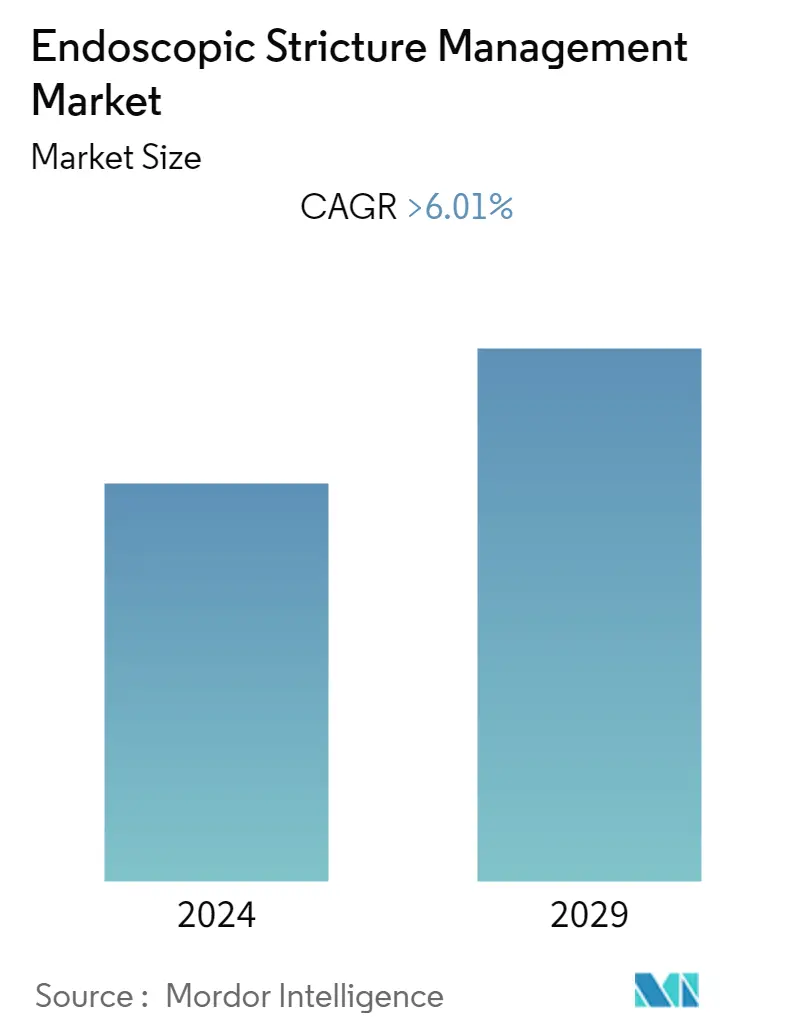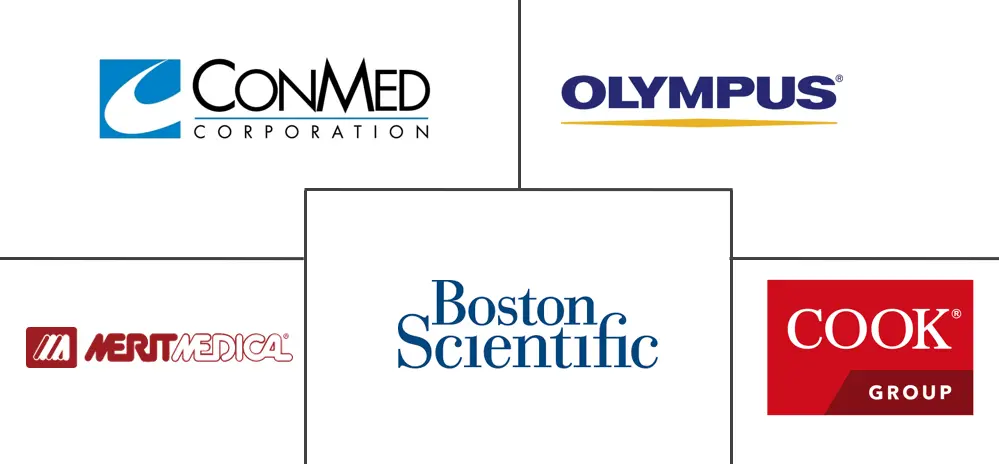Market Size of Endoscopic Stricture Management Industry

| Study Period | 2021 - 2029 |
| Base Year For Estimation | 2023 |
| CAGR | > 6.01 % |
| Fastest Growing Market | Asia Pacific |
| Largest Market | North America |
| Market Concentration | Low |
Major Players
*Disclaimer: Major Players sorted in no particular order |
Endoscopic Stricture Management Market Analysis
The endoscopic stricture management market is expected to register a CAGR of nearly 6.01% during the forecast period.
The COVID-19 pandemic significantly impacted the market during the initial phase due to reduced surgical procedures. However, several stricture surgeries increased during the later stages of the pandemic. The research and development also increased related to stricture-related operations. An article published in Endoscopy International Open-access journal in January 2021 concluded that upper gastrointestinal (GI) stenting increased during the COVID-19 outbreak.
Additionally, as per another article published in the Cureus Journal in September 2021 during the pandemic, google analytics data showed an increased search trend for 18 terms, including urethral stricture. These instances show a demand for stricture management during the initial pandemic days, which is still growing, following various GI diseases. The sector has been recovering well over the last two years, which may lead to market growth in the post-pandemic era.
Factors such as the increasing geriatric population, a rise in the prevalence of GI disorders, new product launches with advanced technologies, and a preference for minimally invasive procedures are expected to fuel the market growth over the analysis period.
GI disorders are increasing globally. This creates the demand for endoscopic stricture management as strictures are commonly found in such diseases. For instance, the increasing colon cancer globally is one of the prime factors bolstering the demand for the prevention of colon stricture, which is a major cause of colon cancer. As per WHO's February 2022 update, colon cancer is one of the most common cancers in the population worldwide. An estimated 1.93 million new cases of colon and rectum cancers were reported globally in the year 2020. In addition, various sources show that in palliative and neoadjuvant settings, stenting is crucial in alleviating esophageal, gastroduodenal, or colorectal obstruction symptoms. Thus, endoscopic insertion of self-expanding metal stents (SEMSs) has a frontline application for managing malignant obstruction or stricture of the gastrointestinal tract (GIT). Thus, the demand for endoscopic stricture management is rising with increased colon cancer. This is expected to contribute to market growth during the analysis period.
Moreover, product launches, approvals, and other strategic activities by regional and global market players contribute to the overall market growth. For instance, in July 2022, Merit Medical Systems launched its pulmonary balloon dilator's most minor and shortest configuration. This new configuration helps physicians to safely dilate challenging strictures, including clogs in short airways, without fear of over-dilating past the intended site. Thus, the product launches are anticipated to fuel the market growth during the analysis period.
Therefore, the factors described above are expected to fuel the studied market growth. However, the lack of professionals with expertise in endoscopic stricture management and the high cost of GI endoscopic procedures are predicted to restrain the development of the market.
Endoscopic Stricture Management Industry Segmentation
Endoscopic stricture refers to an abnormal narrowing or blocking of sections of a tract or canal due to the presence of a tumor or a scar. These strictures are usually treated with endoscopy, a minimally invasive medical method to investigate and operate procedures without making large incisions with the help of various dilation devices and stents.
The Endoscopic Stricture Management Market is Segmented by Type (Balloon Dilators, Stents, and Bougie Dilators), Application (Esophageal, Biliary, and Other Applications), End-user (Hospitals, Ambulatory Surgical Centers, and Other End-users), and Geography (North America, Europe, Asia-Pacific, Middle East and Africa, and South America). The market report also covers the estimated market sizes and trends for 17 different countries across major regions globally. The report offers the value (in USD million) for the above segments.
| By Type | |
| Balloon Dilators | |
| Stents | |
| Bougie Dilators |
| By Application | |
| Esophageal | |
| Biliary | |
| Other Applications |
| By End-user | |
| Hospitals | |
| Ambulatory Surgical Centers | |
| Other End-users |
| By Geography | ||||||||
| ||||||||
| ||||||||
| ||||||||
| ||||||||
|
Endoscopic Stricture Management Market Size Summary
The endoscopic stricture management market is poised for significant growth, driven by factors such as the increasing geriatric population, the rising prevalence of gastrointestinal (GI) disorders, and advancements in minimally invasive technologies. The market experienced initial setbacks due to the COVID-19 pandemic, which led to a reduction in surgical procedures. However, the demand for stricture management surged as GI diseases became more prevalent, with a notable increase in upper gastrointestinal stenting during the pandemic. The market has since shown resilience and is expected to expand further, supported by new product launches and strategic developments by key players. The growing incidence of colon cancer and other GI disorders globally is a major contributor to the demand for endoscopic stricture management, as these conditions often lead to strictures requiring intervention.
In North America, the endoscopic stricture management market is experiencing robust growth, fueled by a rising number of GI disorders and an aging population. The United States, in particular, is witnessing an increase in gastrointestinal cancers, which drives the demand for stricture management devices. The presence of major market players in the region, coupled with ongoing product development and regulatory approvals, further bolsters market expansion. The competitive landscape is characterized by the dominance of global key players, although smaller companies are emerging due to increased awareness and demand for stricture management solutions. Overall, the market is expected to continue its upward trajectory, supported by technological advancements and strategic initiatives by industry leaders.
Endoscopic Stricture Management Market Size - Table of Contents
-
1. MARKET DYNAMICS
-
1.1 Market Overview
-
1.2 Market Drivers
-
1.2.1 Increasing Geriatric Population and Rise in Prevalence of GI Disorders
-
1.2.2 New Product Launches with Advanced Technologies and Preference for Minimally Invasive Procedures
-
-
1.3 Market Restraints
-
1.3.1 Highly Expensive GI Endoscopic Procedures and Troublesome Repayment Approaches
-
1.3.2 Lack of Trained and Skilled Healthcare Professionals in Endoscopic Stricture Technology
-
-
1.4 Industry Attractiveness - Porter's Five Forces Analysis
-
1.4.1 Threat of New Entrants
-
1.4.2 Bargaining Power of Buyers
-
1.4.3 Bargaining Power of Suppliers
-
1.4.4 Threat of Substitute Products
-
1.4.5 Intensity of Competitive Rivalry
-
-
-
2. MARKET SEGMENTATION (Market Size by Volume - in USD Million)
-
2.1 By Type
-
2.1.1 Balloon Dilators
-
2.1.2 Stents
-
2.1.3 Bougie Dilators
-
-
2.2 By Application
-
2.2.1 Esophageal
-
2.2.2 Biliary
-
2.2.3 Other Applications
-
-
2.3 By End-user
-
2.3.1 Hospitals
-
2.3.2 Ambulatory Surgical Centers
-
2.3.3 Other End-users
-
-
2.4 By Geography
-
2.4.1 North America
-
2.4.1.1 United States
-
2.4.1.2 Canada
-
2.4.1.3 Mexico
-
-
2.4.2 Europe
-
2.4.2.1 Germany
-
2.4.2.2 United Kingdom
-
2.4.2.3 France
-
2.4.2.4 Italy
-
2.4.2.5 Spain
-
2.4.2.6 Rest of Europe
-
-
2.4.3 Asia-Pacific
-
2.4.3.1 China
-
2.4.3.2 Japan
-
2.4.3.3 India
-
2.4.3.4 Australia
-
2.4.3.5 South Korea
-
2.4.3.6 Rest of Asia-Pacific
-
-
2.4.4 Middle East and Africa
-
2.4.4.1 GCC
-
2.4.4.2 South Africa
-
2.4.4.3 Rest of Middle East and Africa
-
-
2.4.5 South America
-
2.4.5.1 Brazil
-
2.4.5.2 Argentina
-
2.4.5.3 Rest of South America
-
-
-
Endoscopic Stricture Management Market Size FAQs
What is the current Endoscopic Stricture Management Market size?
The Endoscopic Stricture Management Market is projected to register a CAGR of greater than 6.01% during the forecast period (2024-2029)
Who are the key players in Endoscopic Stricture Management Market?
Boston Scientific Corporation, Merit Medical Systems, CONMED Corporation, Cook Medical LLC and Olympus Corporation are the major companies operating in the Endoscopic Stricture Management Market.

